2019

Multicolor Quantum Control for Suppressing Ground State Coherences in Two-Dimensional Electronic Spectroscopy – J. Lim, C. M. Bösen, A. D. Somoza, C. P. Koch, M. B. Plenio, and S. F. Huelga, Physical Review Letters, 123, 233201 (2019)
DOI: doi.org/10.1103/PhysRevLett.123.233201
Quantum effects in photosynthetic pigment-protein complexes have been experimentally reported based on a nonlinear spectroscopic technique, called two-dimensional electronic spectroscopy. In 2D experiments, three laser pulses interact with a sample, and the electric field emitted from the sample provides rich information about molecular dynamics. Importantly, 2D experiments can reveal oscillatory signals originating from excited state coherences, potentially relevant in energy transport and charge separation dynamics. However, the oscillatory 2D signals can also be induced by ground state coherences, namely vibrational coherences in the absence of electronic excitations, and the unwanted ground state coherences can be spectrally overlapped with the target excited state coherences. The isolation of the excited state coherences from raw 2D data has been a challenging task. In this work, we show that a multi-color pulse sequence can efficiently suppress the ground state coherences in 2D experiments, making raw 2D data dominated by excited state coherences.
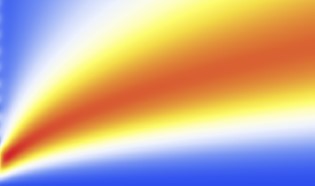
Nanoscale Magnetic Resonance Spectroscopy Using a Carbon Nanotube Double Quantum Dot – W. Song, T. Du, H. Liu, M. B. Plenio, and J. Cai, Physical Review Applied, 12, 054025 (2019)
DOI: doi.org/10.1103/PhysRevApplied.12.054025
Quantum sensing exploits fundamental features of quantum mechanics and quantum control to realise sensing devices that combine unprecedented sensitivity with excellent spatial resolution.
Promising examples include the electron spin of colour centers in diamond but in this work we suggest and examine the use of quantum sensor based on a valley-spin qubit of a carbon nanotube double quantum dot aiming for on-chip nanoscale magnetic resonance spectroscopy. Due to the nanometer diameter of single-walled carbon nanotubes, the valley-spin quantum sensor can be brought extremely close to the target, which promises ultra-high sensitivity and therefore opens a promising route towards integrated on-chip quantum-sensing devices.
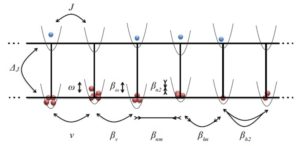
Exciton transport enhancement across quantum Su-Schrieffer-Heeger lattices with quartic nonlinearity – J. J. Mendoza-Arenas, D. F. Rojas-Gamboa, M. B. Plenio, and J. Prior, Physical Review B, 100, 104307 (2019)
DOI: doi.org/10.1103/PhysRevB.100.104307
Transport problems are of considerable interest in a broad range of scientific fields including condensed matter physics and bio-molecular systems. Especially in the latter the modulation of electronic transport properties by the interaction with vibrational degrees of freedom are of particular interest. Typically, these vibrations are assumed to be harmonic but this is not always accurate. Interestingly in the presence of anharmonicities interesting stable structures such as breathers and in this work we have explored to what extent such structures may affect the transport properties in the electronic system.
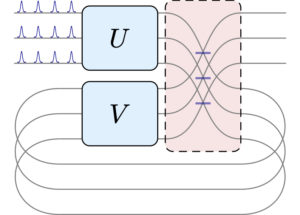
Hybrid spatiotemporal architectures for universal linear optics – D. Su, I. Dhand, L. G. Helt, Z. Vernon, and K. Brádler, Physical Review A, 99, 062301 (2019)
DOI: doi.org/10.1103/PhysRevA.99.062301
Linear optics is a promising platform for building universal quantum computers or for demonstrating quantum speedup via boson sampling. Obtaining a quantum speedup via linear optics requires implementing unitary transformations on many modes of light. Existing approaches to scaling up linear optics to a large numbers of modes either involved large losses (via temporal architectures) or require a large number of optical components (via spatial architectures). We devise a new method that allows combining the advantages of spatial architectures with temporal architectures. This approach could thus enable realising linear optical transformations on a large number of optical modes and enable demonstrations of quantum speedup over classical computers.
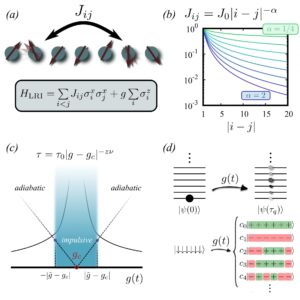
Quantum Kibble-Zurek physics in long-range transverse-field Ising models – R. Puebla, O. Marty, and M. B. Plenio, Physical Review A, 100, 032115 (2019)
DOI: doi.org/10.1103/PhysRevA.100.032115
Second-order phase transitions involve a spontaneous symmetry-breaking at a critical value of an external parameter. In this context we find the Kibble-Zurek mechanism of defect formation, which addresses the symmetry breaking of a finite-time quenched system across a phase transition, and to what extent universal fingerprints survive in a non-equilibrium scenario. In a nutshell, universal behavior refers to the properties that do not depend on the microscopic details. In particular, this mechanism establishes a universal scaling relation between the number of defects, the total time of the driving and the critical exponents. In this work we have studied a one-dimensional Ising model with algebraically decaying couplings. The critical exponents of their phase transitions display a non-trivial dependence on the range and sign of the interaction. Our computed critical exponents shed light on previous incompatible results, which then allow us to corroborate the Kibble-Zurek mechanism’s predictions analyzing the quench dynamics. Finally, we propose a scheme to accurately realize this model via a digital quantum simulation. Our results suggest that universal features in a non-equilibrium setting, e.g. quantum Kibble-Zurek scaling laws, can be observed in state-of-the-art experiments.

Dissipation-Assisted Matrix Product Factorization – A. D. Somoza, O. Marty, J. Lim, S. F. Huelga, and M. B. Plenio, Physical Review Letters, 123, 100502 (2019)
For our understanding of biological function or for the improvement of solar cell efficiencies, charge and energy transfer processes are fundamental and hence the subject of intense study by a broad range of physics communities. A key aspect of this dynamics is the interaction of electronic and vibrational degrees of freedom, with strong vibronic mixing and memory-driven dynamics that result in hybrid dynamics with both quantum and classical features. While a few non-perturbative methods have been developed to address the issue of the high simulation cost, current numerically exact methods are limited to small molecular networks with a few sites and the rich vibrational features of the environment need to be severely coarse-grained. In this work, we develop and demonstrate a new non-perturbative method that allows one to investigate large systems coupled to highly structured environments. Our method can simulate extended systems consisting of 10-50 sites coupled to 100-1000 vibrational modes and it is thus possible to take into account experimentally measured environmental structures in a numerically exact manner. We achieve this by extending the memory-efficient representation of tensor networks (matrix product states/operators MPS/MPO) by combining it with an environment representation that is building on a collection of dissipative vibrational modes. We show that by introducing dissipation, correlations between bath degrees of freedom are suppressed to ensure that the tensor network representation remains efficient. This dissipation-assisted control of system-environmental correlations significantly lowers the simulation cost and enables one to investigate long-time system transients.

Efficient Simulation of Finite-Temperature Open Quantum Systems – D. Tamascelli, A. Smirne, J. Lim, S. F. Huelga, and M. B. Plenio, Physical Review Letters, 123, 090402 (2019)
DOI: https://doi.org/10.1103/PhysRevLett.123.090402
The understanding of the interaction of a quantum system with the surrounding environment is of crucial importance for modern physics, both from a theoretical and from a practical point of view. One of the main obstacles towards a fully satisfactory description of the dynamics of open quantum systems is certainly represented by the characterization of non-Markovian dynamics, in which the memory effects due to the
interaction with the environment cannot be neglected. A powerful idea to deal with quantum non-Markovian evolutions is represented by chain-mapping techniques, which map the original global system-environment configuration into a chain with nearest-neighbor interaction. The main advantage of this mapping is the more local entanglement structure, due to the one-dimensional configuration, which results in a more efficient application of density matrix renormalization group techniques. However, a well-known drawback of such an approach is the unfavorable algorithmic scaling with increasing temperature.
Here, we introduce a modified formulation of the chain mapping, which allows us to overcome the limitation due to finite temperature. The basic idea is to replace the spectral density of a finite-temperature bosonic environment with a modified ("thermalized") spectral density, which can be now referred to a zero-temperature bath, without modifying the dynamics of the open quantum system we are interested in. The resulting speedup and relaxed memory requirements of this approach enable the efficient and certi able simulation of open quantum systems interacting with highly structured environments in any temperature range, with applications extending from quantum thermodynamics to quantum e ects in mesoscopic systems.
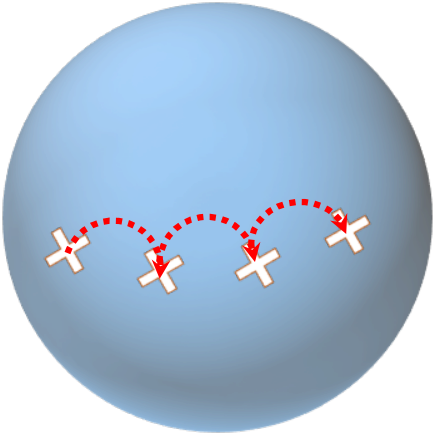
Breaking the quantum adiabatic speed limit by jumping along geodesics – K. Xu, T. Xie, F. Shi, Z.-Y. Wang, X. Xu, P. Wang, Y. Wang, and M. B. Plenio, Science Advances, 5, eaax3800 (2019)
DOI: doi.org/10.1126/sciadv.aax3800
We show theoretically and experimentally that the textbook knowledge regarding the adiabatic speed limit being set by the minimal energy gap in the quantum adiabatic evolution is not correct and moreover, for the first time, we demonstrate, by using a nitrogen-vacancy (NV) center in diamond, that quantum adiabatic evolution can still be maintained even in the presence of vanishing energy gaps as well as energy level crossings. This result challenges traditional views. Underlying our finding is the observation that dynamic phases play the fundamental role in suppressing non-adiabatic transitions. This insight removes the prerequisites of infinite (or very long) evolution time and slow control change imposed by the traditional form of the adiabatic theorem, allowing quantum adiabatic process of unit fidelity in a finite time by jumping on discrete points along the path. As a final remark, unlike shortcuts to adiabaticity, where the quantum evolution does not follow adiabatic process because additional counterdiabatic control fields change the system eigenstates, our jumping method is adiabatic, has strong intrinsic robustness to control errors due to the adiabatic nature of the process, and does not require complex counterdiabatic control fields, which are usually not available in experiments and unavoidably add control errors.
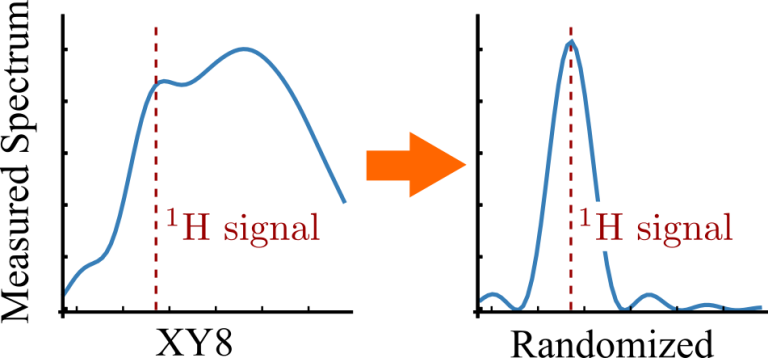
Randomization of Pulse Phases for Unambiguous and Robust Quantum Sensing – Z.-Y. Wang, J. E. Lang, S. Schmitt, J. Lang, J. Casanova, L. McGuinness, T. S. Monteiro, F. Jelezko, and M. B. Plenio, Physical Review Letters, 122, 200403 (2019)
DOI: doi.org/10.1103/PhysRevLett.122.200403
Dynamical decoupling control—an important technique in quantum information processing and quantum sensing—becomes more accurate when randomized phases are used in the control pulses, according to the theory and experiment in this paper. Quantum systems are sensitive to noise and errors, including those from external control. Two important types of errors are imperfections in control pulses and spurious responses due to limited control power and environmental perturbation. The latter leads to false signal identification in quantum sensing, e.g., the misidentification of carbon nuclei for proton nuclei.
This paper demonstrates that instead of a deterministic application, the randomization of pulse phases suppresses both these errors simultaneously. This method is universal and can be directly incorporated into existing dynamical decoupling pulse sequences, allowing unambiguous and robust quantum sensing and quantum control for any physical realization of qubits.
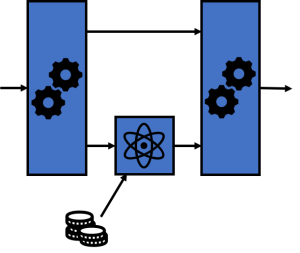
Quantifying Operations with an Application to Coherence – T. Theurer, D. Egloff, L. Zhang, and M. B. Plenio, Physical Review Letters, 122, 190405 (2019)
DOI: doi.org/10.1103/PhysRevLett.122.190405
Resource theories offer the mathematical tools to investigate nonclassical quantum effects and their potential for applications in technology. Until very recently, resource theories were mainly used to determine the nonclassicality of quantum states, which are static resources. Ultimately, however, when speaking about operational advantages of quantum technologies, one is interested in dynamical resources which correspond to nonclassical quantum operations.
In this work, we present a method to determine how nonclassical quantum operations are and apply these finding to the detection of coherence.
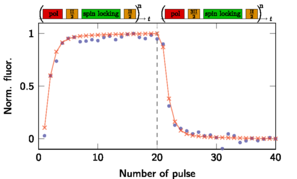
Initialization and Readout of Nuclear Spins via a Negatively Charged Silicon-Vacancy Center in Diamond – M. H. Metsch, K. Senkalla, B. Tratzmiller, J. Scheuer, M. Kern, J. Achard, A. Tallaire, M. B. Plenio, P. Siyushev, and F. Jelezko, Physical Review Letters, 122, 190503 (2019)
DOI: doi.org/10.1103/PhysRevLett.122.190503
Silicon vacancy (SiV) centres in diamond are promising platforms for scalable quantum processors and quantum repeaters due to high spectral stability and efficient photon collection. A main drawback is the limited coherence time, which can be avoided by storing the information on a nearby nuclear spin.
In this work we demonstrate initialization and readout of a 13C nuclear spin with a SiV centre and show that its coherence time is limited by the SiV relaxation time.
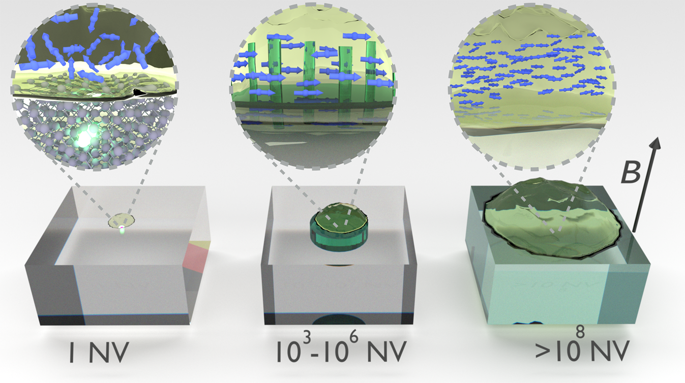
Blueprint for Nanoscale NMR – I. Schwartz, J. Rosskopf, S. Schmitt, B. Tratzmiller, Q. Chen, L.P. McGuinness, F. Jelezko, and M.B. Plenio, Sci. Rep., 9, 6938 (2019)
*This work is licensed under Creative Commons Attribution 4
DOI: doi.org/10.1038/s41598-019-43404-2
The detection and characterization of molecules on the nanometric scale is a holy grail of may scientific fields. Recently nitrogen vacancy (NV) centers in diamond have been used as ultrasensitive magnetometers to perform nuclear magnetic resonance (NMR) spectroscopy of statistically polarized samples at 1–100 nm length scales, providing an opportunity to achieve this goal. However, the spectral linewidth is typically limited to the kHz level, both by the NV sensor coherence time and by rapid molecular diffusion, removing the crucial information of the molecule and making distinguishing different molecules not feasible. Here we provide a blueprint supported by detailed theoretical analysis for a set-up that combines a sensitivity sufficient for detecting NMR signals from nano- to micron-scale samples with a spectral resolution that is limited only by the nuclear spin coherence, i.e. comparable to conventional NMR.
We leverage novel lock-in detection techniques, diamond-based optical hyperpolarization as well as Bayesian inference models for signal processing, thereby making nano/microscale NMR spectroscopy feasible on realistic on sample concentrations, obtaining several orders of magnitude better sensitivity than the current state of the art.
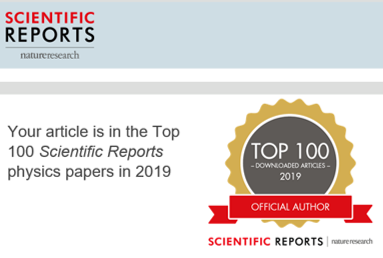
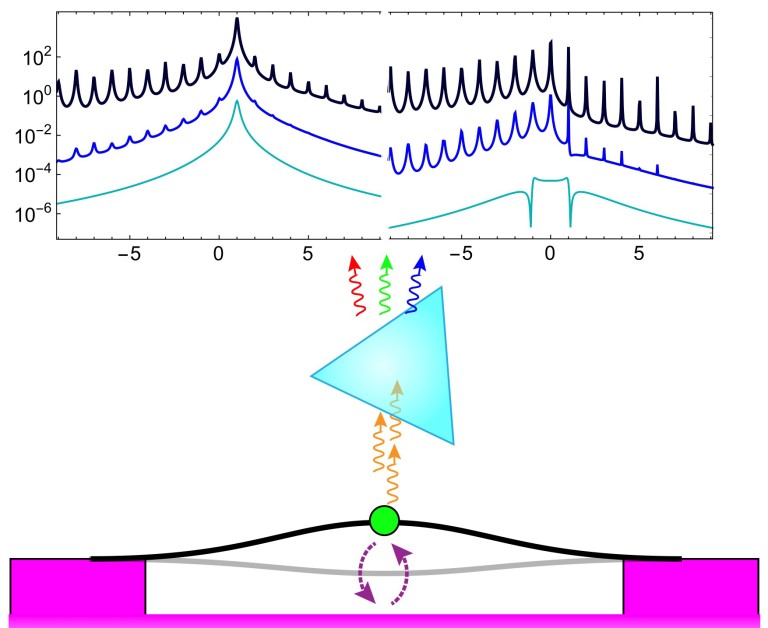
Quantum Effects in a Mechanically Modulated Single-Photon Emitter – M. Abdi and M. B. Plenio, Physical Review Letters, 122, 023602 (2019)
DOI: doi.org/10.1103/PhysRevLett.122.023602
Shake The Emitter, Get a Comb
Frequency combs with fine and orderly teeth are generated out of the single photons emitted from a jiggling atom (color center). When the electronic degrees of freedom of a quantum emitter strongly couple to its motion the radiative transitions get modulated so strongly that the outgoing photons start forming a regulatory framework in the frequency domain; a comb. We show that this can indeed happen for a color center in a freestanding hexagonal boron nitride membrane where the coupling is provided by the Casimir effect.
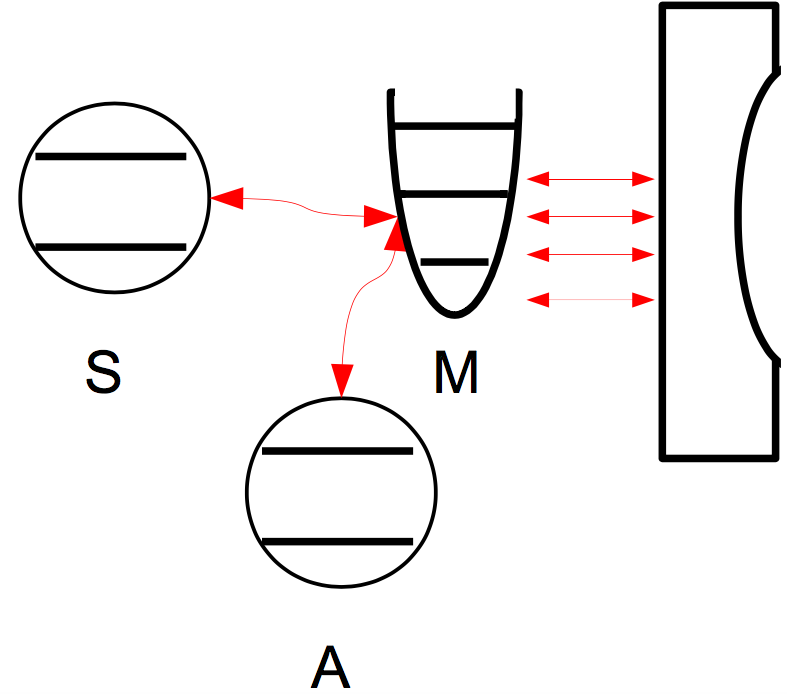
Improving the precision of frequency estimation via long-time coherences – A. Smirne, A. Lemmer, M. B. Plenio, and S. F. Huelga, Quantum Science and Technology, 4, 025004 (2019)
DOI: doi.org/10.1088/2058-9565/aaf43d
One of the most promising routes to exploit quantum mechanics in broad impact technologies is indeed the possibility to use quantum features to determine the value of some unknown parameter (energy splitting, external field, and so on) as precise as possible, possibly overcoming classical standards also in realistic conditions.
In recent years, several estimation strategies have been formulated to deal with the presence of noise, typically relying on the use of quantum entanglement between the sensing probes and on measurements at shorter and shorter time scales with the increasing of the number of probes. Such strategies have been shown to be optimal in the asymptotic limit in the number of probes, but the preparation of a high number of entangled probes and the access to short interrogation times is certainly too demanding in several situations of interest. In this paper, we present a different approach to frequency estimation, which relies on the presence of quantum coherence in the state of each sensing particle in the long time limit, the so-called coherence-trapping phenomenon. First, by means of a commonly used master equation, we show that coherence trapping is obtained by engineering the environment, adding a two-level system properly interacting with it [see also the figure]. After that, we show that our estimation strategy can overcome the precision achievable with entanglement-based strategies for a finite number of probes. Furthermore, we discuss a possible implementation of the scheme in a realistic setup that uses trapped ions as quantum sensors.
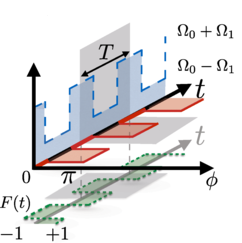
Modulated Continuous Wave Control for Energy-Efficient Electron-Nuclear Spin Coupling – J. Casanova, E. Torrontegui, M. B. Plenio, J. J. García-Ripoll, and E. Solano, Physical Review Letters, 122, 010407 (2019)
DOI: doi.org/10.1103/PhysRevLett.122.010407
In order to manipulate nuclear spins by means of NV-centers in diamond we need to control the electronic degree-of-freedom of the NV by means of microwaves to ensure energetic resonance. With standard protocols, in the presence of high magnetic fields, this requires high Rabi frequencies and hence high field intensities which are hard to generate and may which also lead to increased levels of absorption in target materials. Here we develop an alternative approach where we keep the intensity low but implement rapid phase or amplitude modulation in order to obtain an energetic resonance between electron and nucleus in a rotating frame. We demonstrate that for the same action, e.g. nuclear spin polarisation, our new scheme require much less energy and power.
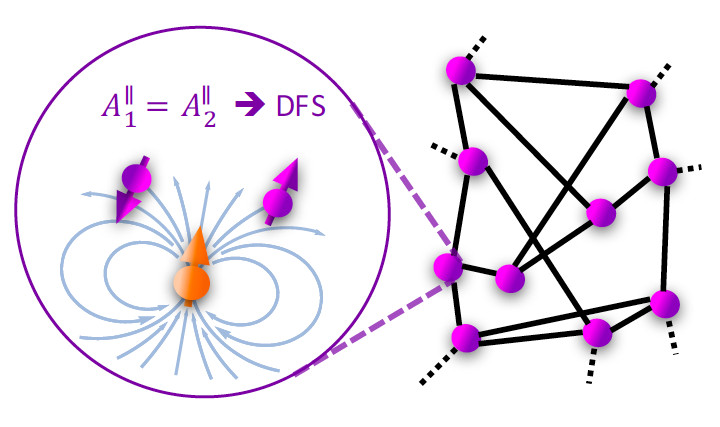
Noise-resilient architecture of a hybrid electron-nuclear quantum register in diamond – M. Perlin, Z. Wang, J. Casanova and M. B. Plenio, Quantum Science and Technology, 4 015007 (2019)
DOI: https://doi.org/10.1088/2058-9565/aade5c
A major obstacle to the development of quantum technologies is reconciling their need to have two opposing features: reliable controls (strong external coupling) and isolation from environmental noise (weak external coupling). These features are required because quantum processes tend to be extremely fragile to errors. This work provides an architecture for a quantum memory register that has both necessary features.
Specifically, in diamond, pairs of carbon-13 nuclei at lattice sites in certain symmetric configurations with respect to a highly controllable nitrogen-vacancy (NV) centre provide natural hardware for a noise-resilient quantum register. Due to the identical spin precession frequencies (i.e. spectral indistinguishability) of such nuclei, this architecture has a decoherence-free subspace (DFS) of nuclear spin states, or a set of states that are immune to the dominant noise from the NV-bound electron as well as fluctuating stray magnetic fields. However, previously existing methods could not access this DFS because of the inability to individually control spectrally indistinguishable nuclear spins. We develop an explicit protocol to store, manipulate, and extract quantum information in such nuclei’s noise-resilient subspace. Our protocol overcomes the obstacle to individual spin control by combining two mature experimental techniques, namely (i) dynamical decoupling, which can selectively couple the NV electron to only a pair of spectrally indistinguishable nuclear spins, and (ii) radio-frequency nuclear spin control, which breaks the symmetry of these nuclear spins with respect to the NV centre, thereby making them distinguishable and allowing for individual spin addressing.
In addition to storing quantum information to allow for quantum sensing, collections of our hybrid registers can be used to perform large-scale quantum communication and computing tasks via existing experimental techniques.

Coherence and non-classicality of quantum Markov processes – A. Smirne, D. Egloff, M. G. Diaz, M. B. Plenio, and S. F. Huelga, Quantum Science and Technology, 4, 01LT01 (2019)
DOI: doi.org/10.1088/2058-9565/aaebd5
The distinction between the classical and the quantum description of physical systems has been a central issue from the birth of quantum mechanics itself. Recently, this topic has been attracting a renewed interest, not only within the purely foundational context, but also due to the experimental capabilities which have led to the observation of possible quantum features in regimes so far unexplored from this point of view; one can think, for example, to transport processes in molecular complexes or super-classical efficiencies of quantum thermal machines. In all these contexts it is clear that quantum coherence does represent the key feature of the quantum description of several physical phenomena, but a precise and unambiguous connection between quantum coherence and non-classicality is still missing.
In this paper, we take some relevant steps towards a rigorous link between quantum coherence and nonclassicality, proving that a Markovian multi-time statistics obtained from repeated measurements of a non-degenerate observable cannot be traced back to a classical statistics if and only if the dynamics generates coherences and subsequently turns them into populations. In this way, on the one hand we identify the relevant property of quantum coherence connected with nonclassicality and on the other hand we clarify when and to which extend the link can be established. This is further supported by a first investigation of the non-Markovian regime, where we show that there can be a genuinely non-classical statistics associated with the measurements of an observable without that any quantum coherence of such observable is present at any time in the state of the measured system.
Contact



Ulm University
Institute of Theoretical Physics
Albert-Einstein-Allee 11
D - 89081 Ulm
Germany
Tel: +49 731 50 22911
Fax: +49 731 50 22924
Office: Building M26, room 4117
Click here if you are interested in joining the group.
Most Recent Papers
Accelerating two-dimensional electronic spectroscopy simulations with a probe qubit protocol, Phys. Rev. Research 7, 023130 (2025), arXiv:2411.16290
13C hyperpolarization with nitrogen-vacancy centers in micro- and nanodiamonds for sensitive magnetic resonance applications, Sci. Adv. 11, eadq6836 (2025), arXiv:2403.14521
YASTN: Yet another symmetric tensor networks; A Python library for Abelian symmetric tensor network calculations, SciPost Phys. Codebases (2025), arXiv:2405.12196
Unlocking Heisenberg Sensitivity with Sequential Weak Measurement Preparation, Quantum 9, 1590 (2025), arXiv:2403.05954
Time dependent Markovian master equation beyond the adiabatic limit, Quantum 8, 1534 (2024), arXiv:2304.06166
